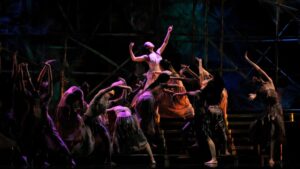Encantada: Women, worship, and the wild

DanceEncantada by Agnes D. LocsinAlice Reyes Dance PhilippinesSamsung Performing Arts Theater: April 14 and 15, 7:30 p.m.; April 15, 2 p.m.Manila Metropolitan Theater: April 21 and 22, 7:30 p.m.; April 22, 2 p.m.
WIDESPREAD acclaim and the newly bestowed mantle of National Artist for Dance have done nothing to ease pre-opening night jitters for Agnes D. Locsin, who is restaging her magnum opus — a full-length piece titled Encantada that tackles the rapacious appetite of man, the destruction of the environment, and the violation of the sacred feminine — to open the season of Alice Reyes Dance Philippines (ARDP).
“It’s bloody,” she said in a video call with BusinessWorld. “For me, the pressure is the work, the beauty of the work. … My standards have gotten higher.”
‘LOCSIN, WE HAVE A CLASSIC’First staged in February 1992, Encantada is a landmark piece that introduced audiences to Ms. Locsin’s neo-ethnic choreography — a fusion of ethnic dance, modern dance, and classical ballet — and later helped cement her legacy as a terpsichorean pioneer.
Featuring music by Joey Ayala and a libretto by Al Santos, Encantada and the nascent sketches leading up to it are detailed over two chapters in Ms. Locsin’s book Philippine Neo-Ethnic Choreography: A Creative Process (2012).
“Let me as early as now clarify that a lot of unpleasant things occur in any creative endeavor,” Ms. Locsin wrote of the year-long process of making Encantada with Messrs. Ayala and Santos. “Ours was what I call a necessary occurrence. We were a perfect creative team but highly volatile. Three strong personalities, each one capable of taking the directorial seat.”
In the end, Ms. Locsin had the final say.
The multimillion production is a generous display of the breadth and depth of her research-based choreography. Listed in her book are references to Catholic gestures of genuflection and flagellation, Marinduque’s Moriones festival, Manobo healing rituals, Cebu’s Sinulog festival, Baguio’s Grand Cañao Festival, Balinese trance dancing, and Kalibo’s Ati-Atihan festival.
The climactic “Digmaan” section, which takes place in the middle of the Encantada’s second act, was a challenge to choreograph since the members of the triumvirate each had their own idea of what it had to be and what it had to accomplish.
In her book, she writes that packed in that “10-minute visualization of a battle in epic proportions” are “ritual fighting, deforestation, rape of nature, and kaingin.”
“I dug into it,” she said in the video call of the war scene, which was inspired by Mindanao’s Moro-Moro and Luzon’s Commedia dell’Arte. “I think I succeeded. … It was — and will probably always be — my favorite.”
Despite the standing ovations Encantada received during its premiere, almost 20 years had to pass before its creators realized the abiding cultural impact of the piece and their place in the pantheon of Philippine dance.
Ms. Locsin remembers that after catching a show at the Cultural Center of the Philippines (CCP) in 2011 — the last time Encantada was restaged — Mr. Ayala turned to her and said: “Locsin, we have a classic.” And gave her a high five.
(Long-time collaborators, Ms. Locsin and Mr. Ayala met as students at Ateneo de Davao University; they call each other by their last names as schoolmates are wont to do.)
This year’s restaging, overseen by Ms. Locsin, 65, stays as faithful to the original as possible. The iconic Encantada mountain by National Artist for Theater and Design Salvador “Badong” F. Bernal will rise in the Samsung Performing Arts Theater, which approximates the Main Theater of the Cultural Center of the Philippines (CCP) in size; and Manila Metropolitan Theater, which has a smaller footprint.
A cast of about 35 dancers, composed of ARDP members who are experiencing Ms. Locsin’s muscular yet precise choreography for the first time and several veterans whose bodies were forged by it, are tasked with preserving the integrity of her vision.
“They’re the future,” she said of this intergenerational mix. “As much as possible, we impart to the dancers how it should and must be done to the best of their ability.”
‘PREPARAR KA’Georgette Sanchez-Vargas, 48, was standing in the middle of a hardware store when she received a message from Ms. Locsin: “Preparar ka.” (Ilonggo for “Be prepared.”)
It was a foregone conclusion that Ms. Sanchez-Vargas, who was 16 when she started working with Ms. Locsin, would reprise Encantada’s gut-wrenching title role (for which she won a Gawad Buhay Award in 2011).
She feels that she is now better prepared for the task, having more life experience to draw on. “So many things have happened in the past few years,” she said in the vernacular.
Her connection to the piece is deep and familial: she has danced in every iteration of Encantada and she is related to its choreographer (Ms. Locsin is the cousin of Ms. Sanchez-Vargas’ mother).
“I appreciate the images created by Agnes more. … The way she taught us how to control our bodies is amazing,” she said. “With Agnes, everything is particular — even your fingers and the way you stand. It’s very intense.”
Returning to the stage with Ms. Sanchez-Vargas are Kris-Belle Paclibar-Mamangun, a former member of Cirque du Soleil, who will alternate in the role of Babaylan with Carissa Adea (who won a Gawad Buhay Award for her performance in 2011).
Compared to these three, ARDP’s Monica A. Gana is a neophyte when it comes to the neo-ethnic style. She recently got a taste of it when she performed in Ms. Locsin Igorot, as part of a show that paid tribute to Ms. Locsin and ARDP founder Alice G. Reyes.
“It was quite mind boggling to be able to understand how one could feel the ground on shoes that were originally created to make dancers look like they’re floating onstage. But that’s where the attention to detail came in,” Ms. Gana said in an e-mail. “It was how you would tap or stomp your shoe on the floor. The lengthening of the entire body while still being connected to the ground as we bourree on pointe. Even in doing the traveling combination of steps, instead of thinking of hitting positions like the arabesque or the grand jete, it was more of how I will transfer my ‘center.’”
When she watched a recording of the 2011 performance, Ms. Gana was struck by the athleticism and stamina Encantada required of the ensemble.
“In most ballets, there are big group dance sections but most of the physically demanding steps are done by the leads. But in Encantada, it’s everyone,” she said. “A number of my colleagues have performed Encantada and they all affirmed how demanding it was not only physically but emotionally. But, when they shared their stories, it seemed like it was one of their best career experiences. … We have to work together to breathe and dance as one. No one should be left behind. We each have a responsibility to support and bring each other up.”
EVERGREEN MESSAGEThe message of Encantada is as enduring as Ms. Locsin’s neo-ethnic choreography. The piece, which opened in the wake of a flash flood that devastated Ormoc City in November 1991 and claimed thousands of lives, comes down hard on humanity’s disregard for the environment.
“We do a lot of things to destroy nature. It will come back to us,” said Ms. Sanchez-Vargas. “Karma is a bitch. You’ll see it in the ballet.”
Aside from Encantada, Ms. Locsin has choreographed Alay sa Puno, a suite of dances meditating on the movement of trees: Ugat, Dahon, Puno, Sanga, Bulak, and Bunga.
In her downtime, she tends to her mini forest, which she calls her Santuario ng Puno, composed of hardwood and ornamental trees. “They grow so slowly,” she said with a laugh of the acacia, narra, and molave she has planted. “Mamamatay na lang ako, wala pa itong mga puno ko.”
While her saplings need more time to spread their roots and stretch skyward, Ms. Locsin’s neo-ethnic choreography has already reached its zenith with Encantada.
Prior to joining a contemporary art museum and a small independent press as a publishing consultant, Sam L. Marcelo was a reporter and editor at BusinessWorld.




